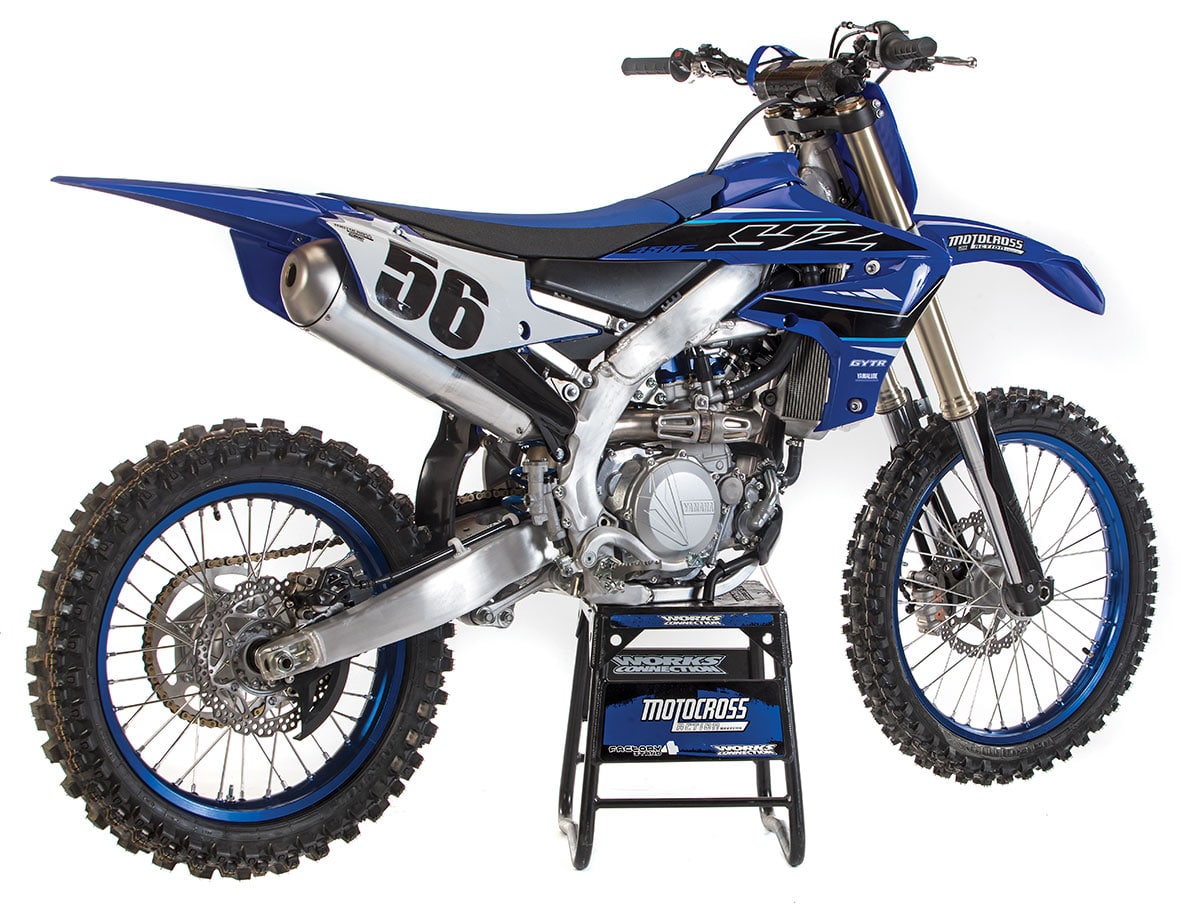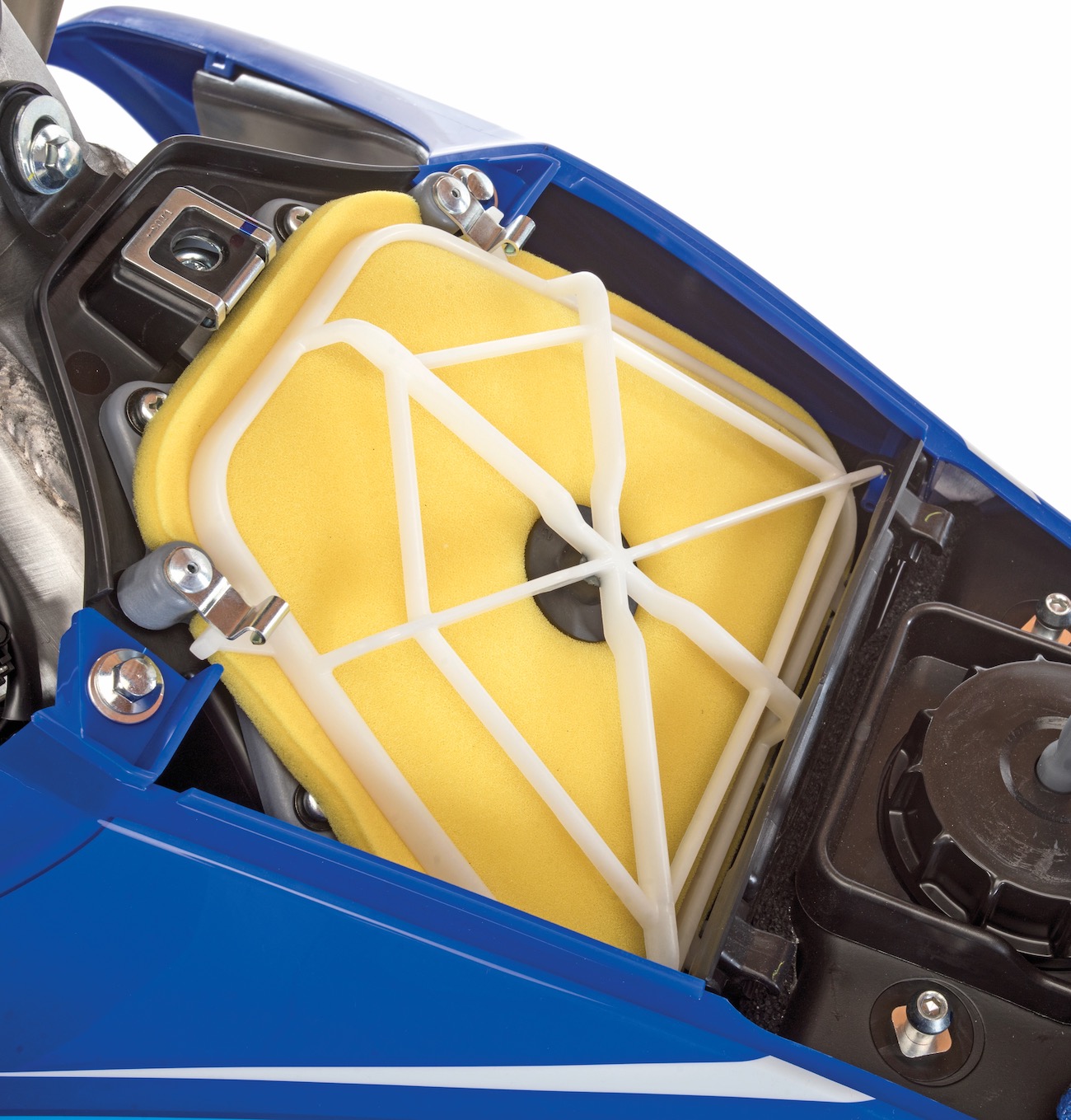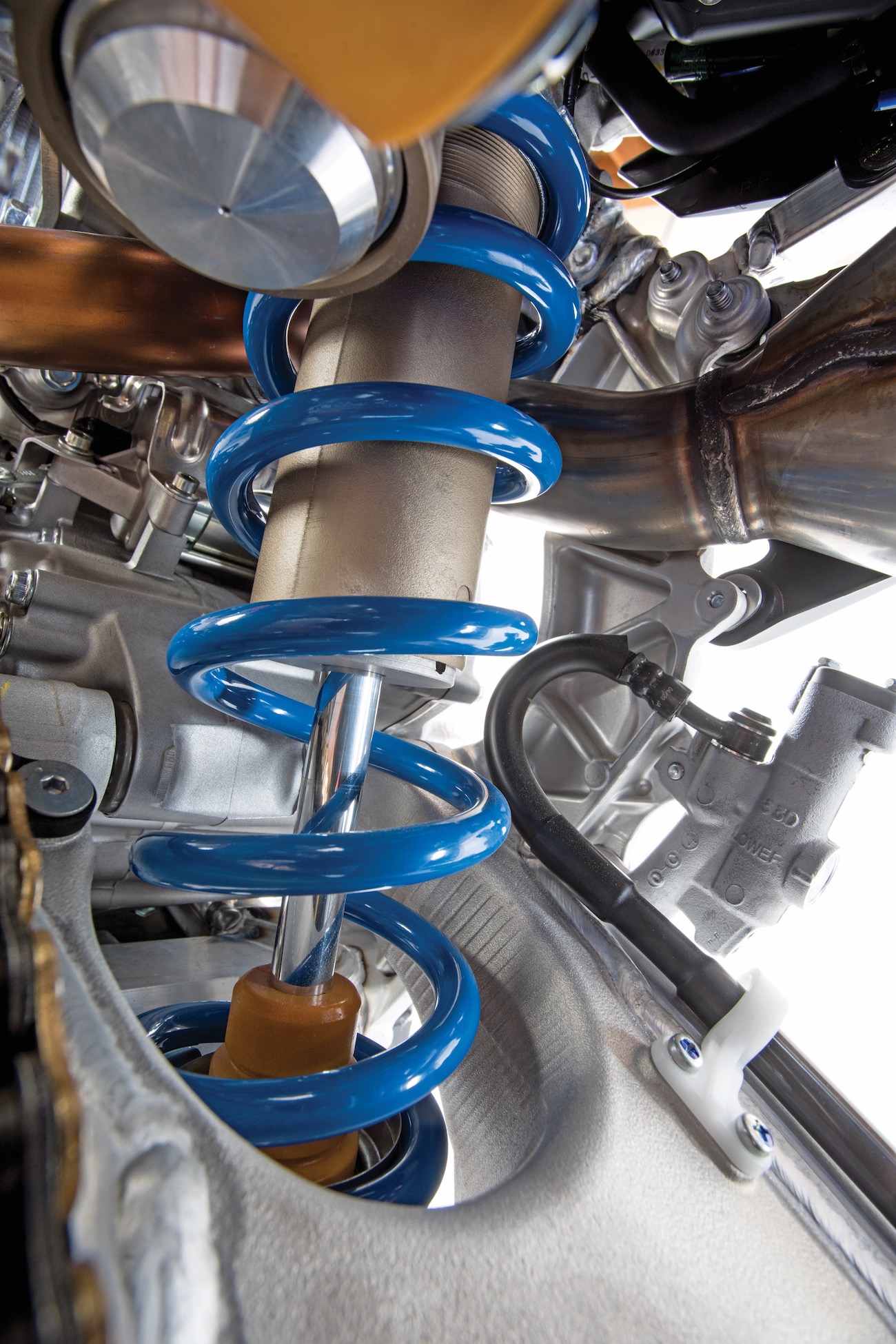MXA RACE TEST: THE REAL TEST OF THE 2021 YAMAHA YZ450F

MXA RACE TEST: THE REAL TEST OF THE 2021 YAMAHA YZ450F
Q: IS THE 2021 YZ450F BETTER THAN THE 2020 YAMAHA YZ450F?
A: No. Last year’s 2020 YZ450F got a boatload of updates to the cams, connecting rod, combustion chamber, valve angle, head height, compression ratio, head pipe diameter, frame wall thickness, motor mounts and head stays. Thus, Yamaha’s engineers and marketing men didn’t feel the need to spend R&D money on the 2021 YZ450F.
Q: HOW DOES THE 2021 YAMAHA YZ450F RUN ON THE TRACK?
A: In actuality, the 2021 YZ450F is a high-rpm engine disguised as a low-to-mid machine. The overall powerband has two distinct parts that are almost seamlessly integrated with each other, so much so that you would never assume that the 2021 Yamaha YZ50F is just lolly-gagging along below 9000 rpm. Above nine grand is where it does its best work. Everything below that is just adequate enough to get the YZ450F in position to pull the high-rpm trigger.
That doesn’t sound very good, but in motion it is exactly what the doctor ordered for the YZ450F, which previous to 2020 was a handful in low-to-mid transitions. Slowing the YZ450F down below 9000 rpm fixed the Yamaha’s bad reputation as a bike that didn’t like to hold a line at turn-in. Less power translated into more control, especially at the front tire, and the end result of the unique two-part powerband was better handling. Plus, what it lacked below 9000 rpm, it made up for above it.
Q: DOES THE 2021 YZ450F POWERBAND HAVE A GLITCH?
A: Not really, but test riders have two gripes. First, the initial throttle response coming off of idle is too aggressive. It burps the power on, which can unbalance the chassis. This can be ironed out with a mapping change. Second, the YZ450F rolls through the first half of its powerband with very little urgency. If it were a racehorse, the rider would have to crack the whip to pick up the pace. The powerband has no dips or flat spots, but below nine grand it doesn’t have much surge or burst, either. The YZ450F can be remapped via your cell phone. We would prefer that Yamaha put the Travis Preston map in the blue light spot. It wouldn’t stop rider from remapping, but it wouldn’t require everyone of download a map.
The YZ450F can be remapped via your cell phone. We would prefer that Yamaha put the Travis Preston map in the blue light spot. It wouldn’t stop rider from remapping, but it wouldn’t require everyone of download a map.
Q: WHAT ABOUT DECOMPRESSION BRAKING ON THE ENTRANCE OF TURNS?
A: The 2020 YZ450F, and by proxy the 2021, has less decompression braking in off-throttle situations. It doesn’t chug down as much as it did in years past. How so? The combination of 2020’s longer connecting rod and Yamaha’s 12mm crank offset allows the 2020–’21 YZ450F to coast more when the throttle is chopped. It is much freer on corner entrance, which improves corner efficiency.
Q: WHAT DOES THE 2021 YZ450F DO ON THE DYNO?
A: The 2021 YZ450F dyno numbers tell an interesting story—in three chapters.
First, the 2021 engine is identical to the 2020 engine. Don’t expect any performance gains from an engine that received no performance updates. Case closed.
Second, the 2020–’21 YZ450F engine is not as powerful as the 2019 YZ450F engine, at least not at every step along the curve. Above 6000 rpm, the new and old engine make the same basic power. Where the 2021 engine shows big improvement is from 9000 rpm to sign-off at 11,200 rpm. Don’t think that we are pigeonholing the 2020 YZ450F as a top-end only engine (because it has steady pulling power from low to mid), but it is at its best at high rpm.
Third, the 2021 YZ450F ranks near the bottom in horsepower from 6000 rpm to the high midrange. Once closer to 10,000 rpm, the YZ450F begins to churn out solid numbers and is a contender in the horsepower wars. On the whole, the 2021 YZ450F powerband is less than stellar from low to mid, but in motion that mellower transition makes the YZ450F easier to ride, allows the rider to push a little harder out of corners, and isn’t half as scary as the previous hard-hitting YZ450F engines of the last decade. Yes, it could be better at 6000, 7000 and 8000 rpm, but history proves that the Yamaha YZ450F chassis does not respond well to “too much, too soon.”
Q: HOW DID THE 2021 KAYABA SSS SUSPENSION PERFORM?
A: Since 2006, Yamaha has had the best forks on the track, but more of its competitors are switching to Kayaba forks to close the gap. Yamaha has responded to the interlopers by going stiffer to get the forks to ride higher in their stroke and hold up better under loads, which is strange, because the forks felt like the front of the bike was down. To compensate, we tried dropping the rear sag a few millimeters, but the shock got harsher. In the end, we slid the forks down in the clamps and stayed very close to the stock compression and rebound settings at both ends.
On the shock, most MXA test riders used the the high-speed compression adjuster to soften the feel on square-edged bumps. The shock had a stagey feel, where it would drop, stop and drop again. This can be ironed out with the high-speed compression and rebound clickers. The rebound could be made to work by going one click in either direction. We used the rebound to settle the chassis, especially on the entrance of corners.

Q: HOW DOES THE 2021 YAMAHA YZ450F CHASSIS PERFORM ON THE TRACK?
A: We don’t expect riders who have been turned off by previous YZ450Fs to jump right on the 2021 chassis and fall in love, because the chassis isn’t as lovable as the powerband. The 2020–2021 YZ450F goes a long way towards addressing some, but not all, of the test rider complaints. In 2020, the Yamaha engineers stiffened the rear of the frame and softened the front. This resulted in a chassis that felt more planted in the front than ever before. Most noticeable, the front end didn’t wiggle and wander as much at corner entrance, and the rear end didn’t wallow under acceleration.
Paradoxically, MXA attributes most of the improvements in Yamaha YZ450F handling to the metered power output of the engine. We would hazard a guess that the YZ450F chassis can be overpowered by too much horsepower. For 2020 and 2021, Yamaha found the right mix of horsepower to go with the chassis’ tolerance for being loaded. Most MXA test riders like the handling of the new chassis, especially at corner entrance, when leaned over in a rut, and when front-tire accuracy is of the utmost importance. The source of these handling improvements is linked to the YZ450F’s progressive, steady and non-confrontational style of power.

Q: DID YAMAHA ADDRESS ITS PROBLEM AREAS FOR 2021?
A: Racers buy bikes based on brand loyalty (red, green, blue, yellow, orange or white), displacement size (125, 250 or 450), engine type (two-stroke or four-stroke) and superlative traits. And, they don’t buy bikes based on the same criteria. It’s no secret that YZ450F handling has been controversial over the years, not aided by criticism from the factory Superstars hired to race them. The negatives are that the YZ450F was big, bulky, wide, tall, heavy and didn’t turn accurately. The superlatives were that its Kayaba SSS suspension was excellent and its durability was above reproach.
With no changes for 2021, Yamaha’s engineers chose to let sleeping dogs lie. They were comfortable with this decision given that consumers bought the 2020 YZ450F in large numbers, but it is dangerous to ignore performance categories that your competition is focusing on. For 2020 and 2021, Yamaha’s engineers can check off the “didn’t turn accurately” criticism. As for “big, bulky, wide, tall and heavy,” they have stuck their heads in the sand.
We can forgive a motorcycle manufacturer that makes a serious attempt to keep up with the Joneses, or, in this case, the Mullers, Schultzes, Meyers and Pierers. And, Yamaha has been forced by KTM’s aggressive R&D department to adopt electric starting and pioneer WiFi mapping, but they can’t address the “big, bulky, wide, tall and heavy” grievances without a massive infusion of cash. A new engine, perhaps one that isn’t aimed backwards, would enable the Yamaha to lose up to 7 pounds, which still wouldn’t make the YZ450F as light as the KTM, but it would be better than having it weigh as much as an oil tanker. Plus, a new engine design could incorporate a lighter electric starter, hydraulic clutch and sleeker chassis.
What follows are the areas Yamaha needs to think about for the future.
Q: HOW GOOD ARE THE YZ450F ERGONOMICS?
A: The YZ450F has the worst ergonomics of all the 2021 450 motocross bikes. For loyal Yamaha racers, it is an improvement over what they had before, but for riders transitioning from other brands, it has a host of flaws—and, from a business point of view, you can’t just sell bikes to former Yamaha owners. You have to steal buyers from the competition. Here is where Yamaha should focus its engineering.
Handlebar position. For some reason, Yamaha moved the handlebars 16.5mm farther forward from 2019 to 2020—and they are still way up front for 2021. Yamaha wanted to get the rider farther forward on the bike, but the width of the gas tank voids this. The majority of MXA test riders thought the bar setup was awkward when sitting and lessened their ability to get added leverage on the bars when there were in 2019. We put the bar mounts back to where they were last year (in the back hole with the bar mounts rotated forward). It’s not the end of the world, but it makes you question Yamaha’s choices.
The seat. The stock seat feels like a horse saddle. The foam wears out quickly, and you end up in a hole. Yamaha knows this because in 2019, it increased the foam density by 16 percent. Then, in 2020, it increased density another 10 percent. Yamaha’s engineers could still go firmer. For our taller test riders, we ran a 20mm-taller GYTR seat (and we put the handlebars back to the stock 16.55 farther-forward position). This setup helped lessen the cramped footpeg-to-saddle height for tall riders; however, short riders hated this mod because the bars lifted their arms up, and with the tall seat they couldn’t touch the ground.

Q: HOW GOOD IS YAMAHA’S WI-FI MAPPING?
A: Yamaha has a dedicated button on the clutch side of the handlebars that allows the rider to switch between the stock map and a performance map (the performance map will be indicated by the button lighting up). As a bonus, you can change maps on the fly. If you do nothing, then both maps will have the identical stock map, regardless of the light.
Yamaha is the only brand with smart phone mapping as an OEM feature on a production bike (KTM and Suzuki plan to offer it, but neither has delivered). Yamaha’s Wi-Fi fuel and ignition maps have 16 programmable boxes, and you can change the fuel in 2 percent increments and advance/retard the ignition in 1-degree increments. Yamaha offers pre-programmed maps on the app that allow you to download ready-made maps.
MXA test riders almost universally choose the TP-3 (Travis Preston) map over the stocker, but we have used the TP-5 and GC-1 maps. In truth, the majority of Yamaha rider’s lives would be much easier if Yamaha just put the TP-3 map on the blue-light side of the button.
Q: IS THE YZ450F AIR FILTER DESIGN A PROBLEM?
A: Yes. We hate the 2021 Yamaha YZ450F airbox and air filter design. Yamaha uses a flat piece of foam that lays on top of the backfire screen like a piece of toast. Every time the engine pulses, which can be 10,000 times a minute, the air filter vibrates against the wire screen. The constant pulsing and suction dries up the air filter oil and eventually sucks dirt through the dry spot in the foam. Twin Air offers two better options: (1) An air filter with thicker foam and a plug-in, top-hat style spacer that lifts the Twin Air filter off the backfire screen. (2) Twin Air’s Power Flow kit includes a new sealing ring, taller cage and dome-shaped air filter that doubles the air flow of the YZ450F airbox.
 The mellow, low-to-mid power helps the chassis turn, while the top-end horsepower makes the YZ450F fast. It’s a good combination.
The mellow, low-to-mid power helps the chassis turn, while the top-end horsepower makes the YZ450F fast. It’s a good combination.
Q: HOW MUCH DOES THE 2021 YAMAHA YZ450F WEIGH?
A: At 238 pounds, the 2021 Yamaha YZ450F is 15 pounds heavier than the 223-pound KTM 450SXF. You can feel that weight when loading your bike, when pushing your bike, when turning your bike and when hitting bumps on your bike; however, when you go weightless at the top of a big jump, you can’t feel it. If only we could figure out a way to stay up there.
Q: WHAT DID WE HATE?
A: The hate list:
(1) Exhaust pipe. When you put the cylinder head on backwards, the pipe has to go forwards before it can go backwards. It is a pain to remove.
(2) Weight. Imagine how this bike would feel if it were 15 pounds lighter.
(3) Backwards engine. It was a creative idea back in 2010, but the limitations that it brings to packaging aren’t worth the 11-year-old creativity.
(4) Centralization of mass. Trying to move the weight closer to the center of gravity is a fool’s errand if you have too much mass to begin with.
(5) Noise. If you ride nothing but a YZ450F, you get used to the blaring noise from the muffler and airbox assaulting you from both ends. Our advice to YZ450F owners is to never ride a 2021 Husqvarna, because the silence will scare you into thinking the engine isn’t running.
(6) Grips. Almost any aftermarket grip is better than the stock Yamaha blister producers.
(7) Blue rims. We prefer silver rims, because blue and black rims get beaten up by roost and scratched by tire irons.
A: The like list:
(1) Engine. A great powerband. Not an incredibly powerful engine, but a powerband that helps both the rider and chassis work better together.
(2) Reliability. Nothing is as reliable as a Yamaha YZ450F. It will last forever.
(3) Suspension. Roll it out of the showroom and race it the next day.
(4) Clutch. Yamaha didn’t make any changes to the 2021 clutch, but it is the best of the cable-operated
clutches. Of course, that list only includes Yamaha and Suzuki. Stiffer clutch springs extend plate life.
(5) Brakes. Yamaha updated its brakes in 2020 by increasing the front caliper’s piston size from 22.65mm to 25.4mm, making the front brake pads 29.2 percent larger, increasing the front rotors surface area by 16 percent, and reducing the size of the rear rotor from 245mm to 240mm (with the required caliper and hanger bracket changes).
(6) Plastics. For 2021, you can order two versions of YZ450F plastic. The stock blue color, which is more noticeable because the number-plate backgrounds are blue instead of white, or the Monster Energy Yamaha team plastic, which has more black plastic and a green Monster Energy claw logo. The stock blue version retails for $9399, and the Monster version sells for $9599. You can save $200 by not buying the hideous Monster model.
Q: WHAT DO WE REALLY THINK?
A: The motorcycle business is tough. Every new model year sees at least one all-new competitor that tickles the consumer’s fancy. This year, the prom queen will be the 2021 Honda CRF450. Meanwhile, all of the Japanese brands are staring at a giant gulf between their technology and that of the Austrian brands. Closing that techno-gulf, especially the weight disparity, could cost $10 million in R&D. All in all, Yamaha has fought back against its competitors without breaking the bank. Thanks to superiority in suspension and reliability, Yamaha has built a more-than-competitive machine.
MXA’S 2021 YAMAHA YZ450F SETUP SPECS
This is how we set up our 2020 Yamaha YZ450F for racing. We offer it as a guide to help you find your own sweet spot.
KAYABA SSS FORK SPECS
Yamaha’s SSS suspension is a sure thing. We like that Yamaha’s engineers and test crews don’t mess with success. For hardcore racing, these are MXA’s recommended 2021 Yamaha YZ450F fork settings (stock settings are in parentheses).
Spring rate: 5.0 N/mm
Oil quantity: 290cc
Compression: 9 clicks out
Rebound: 8 clicks out (9 clicks out)
Fork-leg height: 5mm up
Notes: SSS forks can be used for Beginners, Novices, Intermediates and AMA Pros. There’s a setting for everyone. Be very careful with the compression clicker. One clicker is the equivalent of a couple clicks on other brands’ forks.
KAYABA SHOCK SETTINGS
For hardcore racing, these are MXA’s recommended 2021 YZ450F shock settings (stock settings are in parentheses).
Spring rate: 58 N/mm
Race sag: 105mm (100mm stock)
Hi-compression: 1 turn out
Lo-compression: 12 clicks out
Rebound: 11 clicks out
Notes: We thought the 58 N/mm shock spring was going to be too stiff for slower and lighter riders, so we had the 2017 56 N/mm spring with us just in case. Amazingly enough, we had riders as light as 130 pounds still get acceptable race sag from the stiff spring.












Comments are closed.